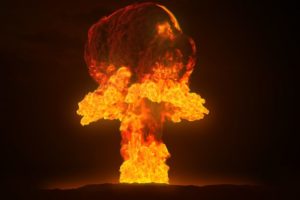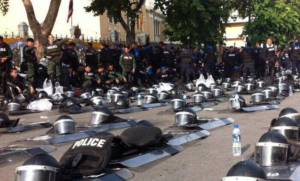“According to recent research, traditional approaches to defense fail because they do not address the underlying cause of violence and conflict: they do not relieve the acute political, ethnic, and religious tensions that fuel terrorism and conflict.”
John Hagelin
“According to recent research, traditional approaches to defense fail because they do not address the underlying cause of violence and conflict: they do not relieve the acute political, ethnic, and religious tensions that fuel terrorism and conflict.”
John Hagelin
John Hagelin
Director of International Center for Invincible Defense
John Hagelin
Director of International Center for Invincible Defense
“Today, every nation is vulnerable. Even the mightiest nations are held hostage by small terrorist groups. Conventional military approaches are increasingly powerless to protect a nation against terrorist attack, against new destructive technologies, or against missiles with pinpoint accuracy.
Diplomatic efforts seem equally powerless. In a world divided by deep-seated hostilities and regional tensions, negotiated settlements and ceasefires have brought temporary relief, at best. Paper treaties and discussions among representatives of warring nations are too fragile a basis for lasting peace.
How, then, can we achieve lasting peace and protect the security, stability, and well-being of every nation?
According to recent research, traditional approaches to defense fail because they do not address the underlying cause of violence and conflict: they do not relieve the acute political, ethnic, and religious tensions that fuel terrorism and conflict. We need an effective means to eliminate these deep-seated tensions—a proven approach that can safeguard a nation against violence and promote peace and prosperity in the world.
During the last 25 years, a powerful, innovative approach to peace has been extensively field tested—in the Middle East and throughout the world. The consistent result has been dramatic reductions in terrorism, war, and other social violence. These findings have been replicated, published in leading academic journals, and endorsed by hundreds of independent scientists and scholars. The efficacy of this approach is now beyond question.
These studies verify that the scientific knowledge and technologies are now available to end terrorism and conflict, to achieve indomitable national strength and security, and to create permanent world peace. By implementing these technologies, every government can rise to invincibility and secure the peace and safety of its citizens. But the time to act is now.”
—John Hagelin, Ph.D.
Executive Director, International Center for Invincible Defense
Renowned quantum physicist and public policy expert.
.
Invincible Defense
Achieving National Security & Invincibility Through the Science & Technology of The Unified Field
“Today, every nation is vulnerable. Even the mightiest nations are held hostage by small terrorist groups. Conventional military approaches are increasingly powerless to protect a nation against terrorist attack, against new destructive technologies, or against missiles with pinpoint accuracy.
Diplomatic efforts seem equally powerless. In a world divided by deep-seated hostilities and regional tensions, negotiated settlements and ceasefires have brought temporary relief, at best. Paper treaties and discussions among representatives of warring nations are too fragile a basis for lasting peace.
How, then, can we achieve lasting peace and protect the security, stability, and well-being of every nation?
According to recent research, traditional approaches to defense fail because they do not address the underlying cause of violence and conflict: they do not relieve the acute political, ethnic, and religious tensions that fuel terrorism and conflict. We need an effective means to eliminate these deep-seated tensions—a proven approach that can safeguard a nation against violence and promote peace and prosperity in the world.
During the last 25 years, a powerful, innovative approach to peace has been extensively field tested—in the Middle East and throughout the world. The consistent result has been dramatic reductions in terrorism, war, and other social violence. These findings have been replicated, published in leading academic journals, and endorsed by hundreds of independent scientists and scholars. The efficacy of this approach is now beyond question.
These studies verify that the scientific knowledge and technologies are now available to end terrorism and conflict, to achieve indomitable national strength and security, and to create permanent world peace. By implementing these technologies, every government can rise to invincibility and secure the peace and safety of its citizens. But the time to act is now.”
—John Hagelin, Ph.D.
Executive Director, International Center for Invincible Defense
Renowned quantum physicist and public policy expert.
.
Invincible Defense
Achieving National Security & Invincibility Through the Science & Technology of The Unified Field
Statistics
Statistics

More Americans Have Died From Domestic Gunfire that All Wars in US History

Number of Nuclear Explosion Conducted in Various Parts of the Globe from 1945-1998
2,053 explosions depicted over 14 minutes. Isao Hahimoto: “I created this work for the means of an interface to the people who are yet to know of the extremely grave, but present problem, of the world”

More Americans Have Died From Domestic Gunfire that All Wars in US History

Number of Nuclear Explosion Conducted in Various Parts of the Globe from 1945-1998
2,053 explosions depicted over 14 minutes. Isao Hahimoto: “I created this work for the means of an interface to the people who are yet to know of the extremely grave, but present problem, of the world”
Choosing Differently
Choosing Differently


Police in Thailand Lay Down Weapons and Join Protestors


Why Fight?
Four minutes on the true nature of war and fundamental question of why we fight:
Meditation
Could this simple tool bring peace to the world?


Police in Thailand Lay Down Weapons and Join Protestors


Why Fight?
Four minutes on the true nature of war and fundamental question of why we fight:
Meditation
Could this simple tool bring peace to the world?
Denis Kucinich
A Department of Peace
Denis Kucinich
A Department of Peace
A Department of Peace
Denis Kucinich
.
“How can we construct more peaceful selves, homes, cities, nations and the world?” The Department of Peace was not just some airy-fairy notion of, Let’s all get together and sing “Kumbaya.” ’ Which is okay with me. But the Department of Peace is a highly structured approach that puts a permanent place for peace in our national discussion.” Former Senator Denis Kucinich on the idea of a Peace Department
.
How the bill would work
A secretary of peace would sit in the president’s Cabinet and on the National Security Council. The secretary would be given a special new role in the country’s military decisions: If a conflict was about to start, the secretaries of defense and state would have to consult the Peace secretary “concerning nonviolent means of conflict resolution.”
But the new department would be concerned with much more than foreign wars. It would also seek to stop bloodshed in U.S. cities, by funding stop-the-violence programs, programs in schools and “unarmed civilian peacekeeping.”
There would also be a Peace Academy, modeled after the military service academies. After four years, graduates would be required to spend five years in public service, promoting conflict resolution at home or abroad.
And the bill would encourage the establishment of a Peace Day. “Such day shall include discussions of the professional activities and achievements in the lives of peacemakers,” the bill says.
The cost of all this? The bill asks for $10 billion per year. That’s a little more than the Environmental Protection Agency and a little less than the Department of Commerce. (Our Defense Budget for 2013 is around $642.5Billion) But Kucinich’s argument is that — if it worked — the Department of Peace would save money in the end. By not getting into military conflicts, he said, “we conserve lives. We conserve America’s resources. We conserve America’s money.”
He never got the chance: The bill has been introduced now six times, and never made it out of committee. But Kucinich believes that the bill will carry on when he’s gone: He has been looking for a colleague to take it up next year. “It’ll get reintroduced. No question about it,” Kucinich said.
“This is an idea whose time is coming.”
A Department of Peace
Denis Kucinich
.
“How can we construct more peaceful selves, homes, cities, nations and the world?” The Department of Peace was not just some airy-fairy notion of, Let’s all get together and sing “Kumbaya.” ’ Which is okay with me. But the Department of Peace is a highly structured approach that puts a permanent place for peace in our national discussion.” Former Senator Denis Kucinich on the idea of a Peace Department
.
How the bill would work
A secretary of peace would sit in the president’s Cabinet and on the National Security Council. The secretary would be given a special new role in the country’s military decisions: If a conflict was about to start, the secretaries of defense and state would have to consult the Peace secretary “concerning nonviolent means of conflict resolution.”
But the new department would be concerned with much more than foreign wars. It would also seek to stop bloodshed in U.S. cities, by funding stop-the-violence programs, programs in schools and “unarmed civilian peacekeeping.”
There would also be a Peace Academy, modeled after the military service academies. After four years, graduates would be required to spend five years in public service, promoting conflict resolution at home or abroad.
And the bill would encourage the establishment of a Peace Day. “Such day shall include discussions of the professional activities and achievements in the lives of peacemakers,” the bill says.
The cost of all this? The bill asks for $10 billion per year. That’s a little more than the Environmental Protection Agency and a little less than the Department of Commerce. (Our Defense Budget for 2013 is around $642.5Billion) But Kucinich’s argument is that — if it worked — the Department of Peace would save money in the end. By not getting into military conflicts, he said, “we conserve lives. We conserve America’s resources. We conserve America’s money.”
He never got the chance: The bill has been introduced now six times, and never made it out of committee. But Kucinich believes that the bill will carry on when he’s gone: He has been looking for a colleague to take it up next year. “It’ll get reintroduced. No question about it,” Kucinich said.
“This is an idea whose time is coming.”
“Violence is fear in action. Fear is an avoidance of sadness. Sadness is an aversion to loneliness. Loneliness is a denial of emptiness. Emptiness is the presence of being. The presence of being is awakened consciousness.”
****
“Through an awareness of fear, violence no longer becomes an option. As fear is faced, sadness is encountered. As sadness is encountered, loneliness is acknowledged. As loneliness is acknowledged, emptiness is recognized. As emptiness is recognized, a presence of being is discovered. As a presence of being is discovered — consciousness awakens.”
****
“In noticing how the deepest pain inevitably leads to your most profound spiritual discovery, I invite you to support the end of violence by acknowledging any discomfort as a catalyst to your highest evolution. As you take the time to face what is unresolved in your heart, waves of high vibrational energy are sent throughout the field of consciousness. With every wave entering each energy field, it inspires those who use violence to avoid their soul’s journey to come out hiding and surrender at last. This is the heart of transformation.” Matt Kahn
“Violence is fear in action. Fear is an avoidance of sadness. Sadness is an aversion to loneliness. Loneliness is a denial of emptiness. Emptiness is the presence of being. The presence of being is awakened consciousness.”
****
“Through an awareness of fear, violence no longer becomes an option. As fear is faced, sadness is encountered. As sadness is encountered, loneliness is acknowledged. As loneliness is acknowledged, emptiness is recognized. As emptiness is recognized, a presence of being is discovered. As a presence of being is discovered — consciousness awakens.”
****
“In noticing how the deepest pain inevitably leads to your most profound spiritual discovery, I invite you to support the end of violence by acknowledging any discomfort as a catalyst to your highest evolution. As you take the time to face what is unresolved in your heart, waves of high vibrational energy are sent throughout the field of consciousness. With every wave entering each energy field, it inspires those who use violence to avoid their soul’s journey to come out hiding and surrender at last. This is the heart of transformation.” Matt Kahn
“With experience, we can accept the fact that we made our circumstances and start to correct our errors by making causes for what we want in our lives, rather than what we do not want.”
Maticintin, Wisdom Master
“With experience, we can accept the fact that we made our circumstances and start to correct our errors by making causes for what we want in our lives, rather than what we do not want.”
Maticintin, Wisdom Master